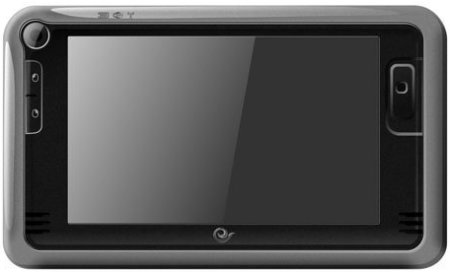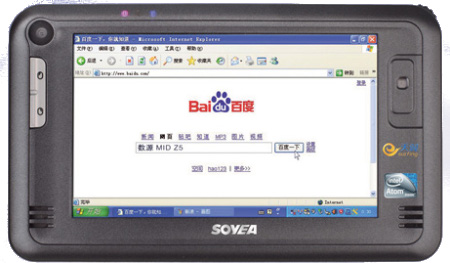MID runs Linux on dual-speed Atom
Nov 2, 2009 — by Eric Brown — from the LinuxDevices Archive — 4 viewsChinese manufacturer Soyea has begun taking orders for a mobile Internet device (MID) that runs Linux or Windows XP on Intel's dual-speed, MID-oriented Z515 Atom CPU. Soyea's Z5 is equipped with 1GB RAM, an 8GB SSD, a five-inch touchscreen, plus 3G, WiFi, Bluetooth, and a three-megapixel webcam.
The Soyea Z5 is the first MID we've come across featuring Intel's Atom Z515 CPU, which was announced in April along with a 2GHz Z550 version. Upon their release, both Atom CPUs specifically targeted the small-scale tablets known as mobile Internet devices.
Unlike the original Atom Z5xx parts, the Z515 sports the unique (at least for the Atom) ability to run at two different clock speeds. The Z515 can run at 800MHz, achieving an 80mW idle power, 160mW average power, and 0.65 Watt TDP, or shift upwards to 1.2GHz, at which point it has a 1.4 Watt TDP — still lower than the 2 Watt TDP of Intel's previous 1.1GHz Z510. The Z515 uses the familiar "Poulsbo" companion chip, the SCH US15W, which supports a 400MHz or 533MHz front-side bus.

Soyea Z5 MID

Z5 switched on
Aside from the CPU, the keyboardless device appears to be fairly typical for a MID, offering a five-inch WVGA (800 x 480) touchscreen. For communications, it provides a 3G/CDMA2000 cellular radio that supports China Telecom's 3G network, plus 802.11b/g WiFi, and Bluetooth 2.0 + EDR, says Soyea.
Weighing 12.3 ounces and measuring 6.1 x 3.7 x 0.9 inches, the device further supplies a three-megapixel webcam, VGA port, stereo speakers, and an optical mouse, says the company.
MIDs treading water
Intel launched the mobile Internet device (MID) format in 2007 as the proper companion to the original Intel Atom, and when the first Atom chips appeared back in April 2008, dozens of the small tablets were promised for the holiday market.
MIDs did start appearing last fall, but there were not as many as expected, and few were marketed in the U.S. Before the holiday season was even finished, it was clear that MIDs were in trouble, and this June, estimates were published that only 30,000 Atom-based MIDs had been sold, in contrast with Intel's projections of 150,000 to 200,000 units sold in the first year. Most of these appear to have been sold in East Asia.
Since then, the relatively few new MIDs that have appeared have been just as likely to run an ARM-based processor than an Intel Atom, with several of the ARM MIDs running Android. One potentially interesting newcomer is a rumored Android-based MID offered by Dell.
The MID format's lack of success has in part been due to the disappointing battery life of the original Atoms, something that the Z515 may begin to improve. Yet, the devices have also been sandwiched by the popularity of slightly netbooks on the one hand, and high-end smartphones on the other.
Intel, which has racked up considerable sales for its N270 Atom variant on netbooks, has promised to relaunch the MID format when the faster, more energy efficient Moorestown chip ships for the upcoming Moblin v2.1 for Handhelds next year. Yet, the industry may instead choose to focus the technology combo on smartphones, or more specifically, according to the Moblin project, "media phones."
Pining for the Pineview
The Z515 is an incremental step toward improving Atom's power efficiency, but Intel's next generation of "Pineview"Atom processors should offer greater gains. Expected to launch on Jan. 3, the Pineview/Atom N450, D410, and D510 processors will extend netbook battery life and may allow HD video playback, among other predicted advantages.
The Pineview chips support Intel's "Pine Trail" platform, which shrinks the number of chips required to develop an Atom-based device down to two: the Pineview CPU package, plus an I/O controller called "Tiger Point." The new Atoms will cost about 40 percent more than the parts they replace, but because separate northbridge chips are no longer required, the overall cost will wind up being about the same, Intel has said.
Availability
The Soyea Z5 is available for order now by Amazon China at a pricey 5999 Yuan (about $879 U.S.), but is currently listed as out of stock. More information may be found at this translated Amazon page, here.
This article was originally published on LinuxDevices.com and has been donated to the open source community by QuinStreet Inc. Please visit LinuxToday.com for up-to-date news and articles about Linux and open source.